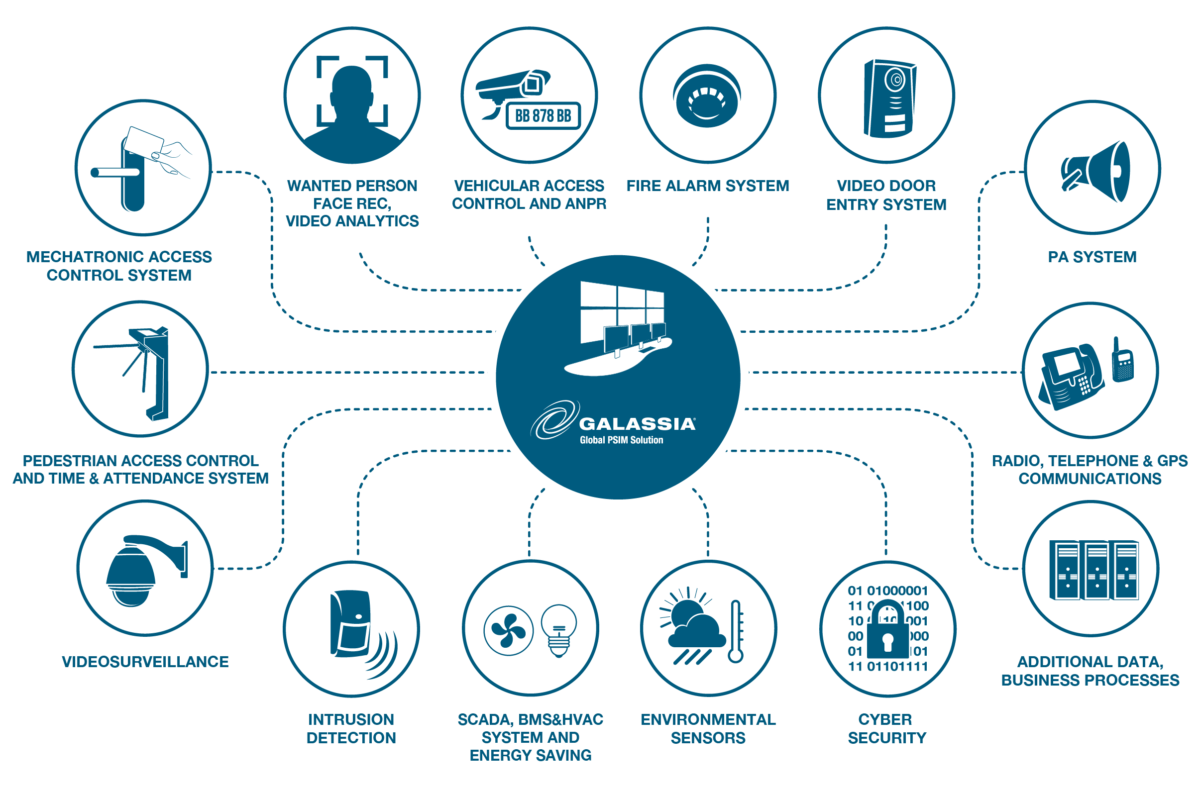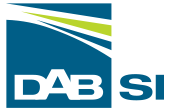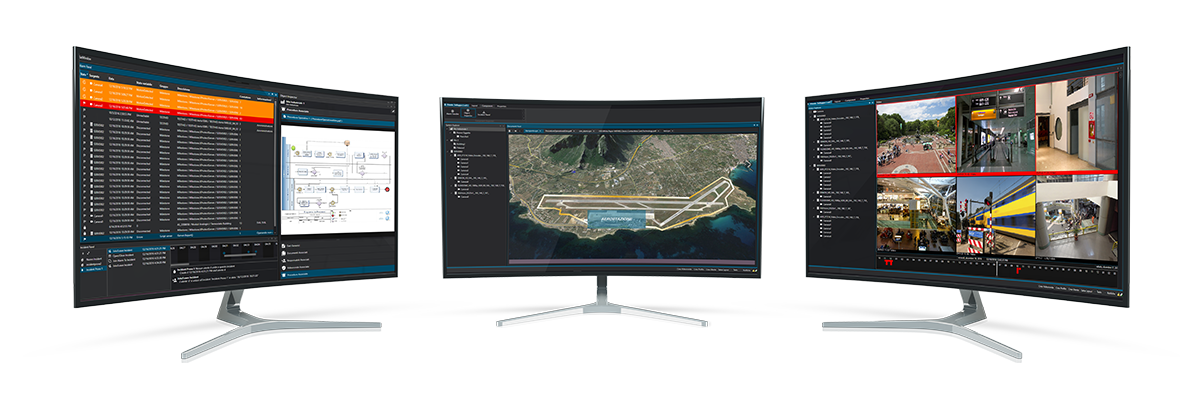
GALASSIA is a supervision and integrated management platform of complex physical security systems (PSIM – Physical Security Information Management) which can centralise, monitor and interact with different types of sensors, equipment and multi-brand security, safety and technological control systems, providing a complete security package.
It is an open, scalable and flexible Enterprise level client/server solution for implementing central monitoring units and advanced control to manage systems located in one or more different geographical sites.
Galassia is a software solution that complies with the new privacy regulations (GDPR).
Features
Integrated management of Video surveillance, Intrusion detection, Access control, Video entry control, Fire detection, PA systems, Communication, Building
Intake, analysis and correlation of events and different types of alarms
Integration of multiple brands within the overview of security devices
Support for numerous communications protocols
Customisable systems architecture
Balanced management between different systems
Adaptability to different requirements now and in the future
Readiness for operation in different application environments
Remote management of multiple sites with different levels of hierarchy
Graphical user interface
Advanced programming and scripts, SDK and DDK availability
Support in managing multiple operators and operations centres
Integrated management of Video surveillance, Intrusion detection, Access control, Video entry control, Fire detection, PA systems, Communication, Building
Intake, analysis and correlation of events and different types of alarms
Integration of multiple brands within the overview of security devices
Support for numerous communications protocols
Customisable systems architecture
Balanced management between different systems
Adaptability to different requirements now and in the future
Readiness for operation in different application environments
Remote management of multiple sites with different levels of hierarchy
Graphical user interface
Advanced programming and scripts, SDK and DDK availability
Support in managing multiple operators and operations centres
Operator interface
- Intake and management based on priorities and levels of severity
- Correlation between events and associated images
- Management of the queue for events among operators
- Event management of multiple security systems
- Graphic representation of information through the use of dynamic icons, navigation toolbars, buttons, animation
- Advanced navigation on vector graphic maps
- Integration with GIS systems
- Automatic pop-up of area linked to the event
- Virtual matrix management for viewing images generated by devices in the field
- Control of camera pan/tilt functions through a graphic interface or joystick
- Planning of video inspections linked to events
- Integration with video analysis and license plate recognition systems
- Management of sites and associated data
- Integration and automation of telephone/radio communications and PA systems
- Management of access levels based on different levels of hierarchy
- Integrated management of security procedures through workflows
- Management of on-site resources (operational units)
- Smartphone apps
- Work Force Management (dispatching of field resources and reporting)
- User personal data management, credentials and access permits
- Centralisation of transit generated by multiple sites
- Visual identification of staff accessing the entrances with comparison between live images and archived photos
- Intake and management based on priorities and levels of severity
- Correlation between events and associated images
- Management of the queue for events among operators
- Event management of multiple security systems
- Graphic representation of information through the use of dynamic icons, navigation toolbars, buttons, animation
- Advanced navigation on vector graphic maps
- Integration with GIS systems
- Automatic pop-up of area linked to the event
- Virtual matrix management for viewing images generated by devices in the field
- Control of camera pan/tilt functions through a graphic interface or joystick
- Planning of video inspections linked to events
- Integration with video analysis and license plate recognition systems
- Management of sites and associated data
- Integration and automation of telephone/radio communications and PA systems
- Management of access levels based on different levels of hierarchy
- Integrated management of security procedures through workflows
- Management of on-site resources (operational units)
- Smartphone apps
- Work Force Management (dispatching of field resources and reporting)
- User personal data management, credentials and access permits
- Centralisation of transit generated by multiple sites
- Visual identification of staff accessing the entrances with comparison between live images and archived photos
Benefits
INCREASED SECURITY
Increased efficiency in the centralised management of individual assets
COST SAVING
Optimisation of global control with reduction in the overall costs of security, surveillance and protection
INDEPENDENCE FROM MANUFACTURERS
Freedom to use or replace the technology of different manufacturers of security systems at any time
SITUATIONAL AWARENESS MANAGEMENT
Management of events through the display of situation-related information
REDUCTION OF TCO – TOTAL COST OF OWNERSHIP
Reduction of TCO by safeguarding the investments incurred in implementing security systems
CYBER SECURITY
Monitoring of IP security systems with the identification of internal and external attacks
EFFICIENT AND EFFECTIVE TECHNOLOGY
Guarantee of the efficiency and effectiveness of your technology investments through ongoing checks on system operation
SAFEGUARDING INVESTMENTS
Integration of pre-existing security systems
INCREASED PRODUCTIVITY OF OPERATIONS CENTRE STAFF
Optimisation of the employment of resources used for management (reduced hours, consolidation, use of hierarchical levels)
CONSISTENT MANAGEMENT AND ERROR REDUCTION
Management of alarm events based on operating procedures for multiple sites, with consistent rules and reports
IMPROVEMENT OF PROCEDURES
Analysis and streamlining of procedures and the creation of a uniform database of events – Incident Management
ENERGY SAVINGS
Optimisation/reduction in energy consumption through interoperability with Building Management Systems (BMS)
INCREASED SECURITY
Increased efficiency in the centralised management of individual assets
COST SAVING
Optimisation of global control with reduction in the overall costs of security, surveillance and protection
INDEPENDENCE FROM MANUFACTURERS
Freedom to use or replace the technology of different manufacturers of security systems at any time
SITUATIONAL AWARENESS MANAGEMENT
Management of events through the display of situation-related information
REDUCTION OF TCO – TOTAL COST OF OWNERSHIP
Reduction of TCO by safeguarding the investments incurred in implementing security systems
CYBER SECURITY
Monitoring of IP security systems with the identification of internal and external attacks
EFFICIENT AND EFFECTIVE TECHNOLOGY
Guarantee of the efficiency and effectiveness of your technology investments through ongoing checks on system operation
SAFEGUARDING INVESTMENTS
Integration of pre-existing security systems
INCREASED PRODUCTIVITY OF OPERATIONS CENTRE STAFF
Optimisation of the employment of resources used for management (reduced hours, consolidation, use of hierarchical levels)
CONSISTENT MANAGEMENT AND ERROR REDUCTION
Management of alarm events based on operating procedures for multiple sites, with consistent rules and reports
IMPROVEMENT OF PROCEDURES
Analysis and streamlining of procedures and the creation of a uniform database of events – Incident Management
ENERGY SAVINGS
Optimisation/reduction in energy consumption through interoperability with Building Management Systems (BMS)
System Architecture

Technology





